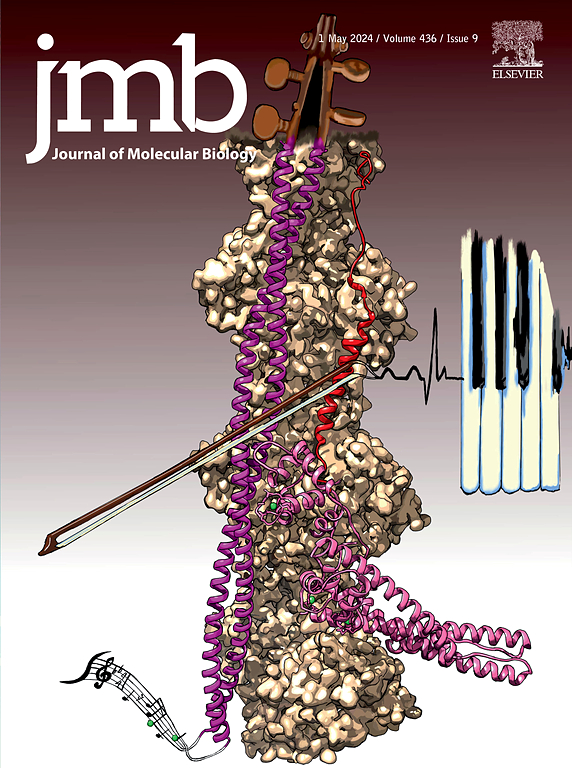ATP as a Key Modulator of Fused-in-sarcoma Phase Separation and Aggregation: Insights into Amyotrophic Lateral Sclerosis Pathogenesis
IF 4.5
2区 生物学
Q1 BIOCHEMISTRY & MOLECULAR BIOLOGY
引用次数: 0
Abstract
Fused in sarcoma (FUS) is an RNA-binding protein, the aberrant aggregation of which is linked to amyotrophic lateral sclerosis (ALS). Liquid–liquid phase separation (LLPS) of FUS facilitates functional condensate formation and can drive pathological aggregation under certain conditions. The aggregation-inhibitory effects of ATP, a key cellular hydrotrope, have been reported for multiple proteins; however, how ATP, present at approximately 1–12 mM concentrations in cells, regulates LLPS and amyloid fibril formation remains unclear. Therefore, we investigated how ATP modulates the LLPS behavior and aggregation of FUS and its ALS-linked variants, R495X and P525L. ATP destabilized both normal LLPS and aberrant high-pressure LLPS (HP-LLPS), with a relatively strong inhibitory effect on HP-LLPS. Pressure-jump experiments demonstrated that ATP reduced the irreversible aggregation propensity of HP-LLPS, particularly in ALS variants that exhibited enhanced aggregation compared to that by wild-type FUS. Molecular dynamic simulations further revealed that the triphosphate and adenosine moieties of ATP synergistically disrupted intermolecular interactions that were crucial for phase separation, leveraging its amphipathic properties. Notably, ATP concentrations within the physiological range (1–12 mM) significantly inhibited FUS aggregation, suggesting a protective role in cellular environments. These results indicate that decreased intracellular ATP levels may exacerbate aberrant phase transitions of FUS, contributing to ALS onset. This study underscores the potential of ATP as a therapeutic modulator of protein phase separation and aggregation, providing valuable insights into the molecular mechanisms of ALS. Our findings open new avenues for targeting ATP-regulated pathways for treating neurodegenerative disorders.

ATP作为融合肉瘤相分离和聚集的关键调节剂:对肌萎缩性侧索硬化症发病机制的见解。
融合在肉瘤(FUS)是一种rna结合蛋白,其异常聚集与肌萎缩侧索硬化症(ALS)有关。FUS的液-液相分离(LLPS)有利于功能凝析物的形成,在一定条件下可驱动病理聚集。ATP是一种关键的细胞水化合物,它对多种蛋白质的聚集抑制作用已被报道;然而,细胞中浓度约为1- 12mm的ATP是如何调节LLPS和淀粉样纤维形成的仍不清楚。因此,我们研究了ATP如何调节FUS及其als相关变体R495X和P525L的LLPS行为和聚集。ATP对正常LLPS和异常高压LLPS (HP-LLPS)均有不稳定作用,且对HP-LLPS有较强的抑制作用。压力跳变实验表明,ATP降低了HP-LLPS的不可逆聚集倾向,特别是在ALS变异中,与野生型FUS相比,HP-LLPS的聚集性增强。分子动力学模拟进一步揭示了ATP的三磷酸和腺苷部分协同破坏了对相分离至关重要的分子间相互作用,利用了其两亲性。值得注意的是,生理范围内(1-12 mM)的ATP浓度显著抑制FUS聚集,表明其在细胞环境中具有保护作用。这些结果表明,细胞内ATP水平的降低可能会加剧FUS的异常相变,从而导致ALS的发病。这项研究强调了ATP作为蛋白质相分离和聚集的治疗调节剂的潜力,为ALS的分子机制提供了有价值的见解。我们的发现为靶向atp调节通路治疗神经退行性疾病开辟了新的途径。
本文章由计算机程序翻译,如有差异,请以英文原文为准。
求助全文
约1分钟内获得全文
求助全文
来源期刊

Journal of Molecular Biology
生物-生化与分子生物学
CiteScore
11.30
自引率
1.80%
发文量
412
审稿时长
28 days
期刊介绍:
Journal of Molecular Biology (JMB) provides high quality, comprehensive and broad coverage in all areas of molecular biology. The journal publishes original scientific research papers that provide mechanistic and functional insights and report a significant advance to the field. The journal encourages the submission of multidisciplinary studies that use complementary experimental and computational approaches to address challenging biological questions.
Research areas include but are not limited to: Biomolecular interactions, signaling networks, systems biology; Cell cycle, cell growth, cell differentiation; Cell death, autophagy; Cell signaling and regulation; Chemical biology; Computational biology, in combination with experimental studies; DNA replication, repair, and recombination; Development, regenerative biology, mechanistic and functional studies of stem cells; Epigenetics, chromatin structure and function; Gene expression; Membrane processes, cell surface proteins and cell-cell interactions; Methodological advances, both experimental and theoretical, including databases; Microbiology, virology, and interactions with the host or environment; Microbiota mechanistic and functional studies; Nuclear organization; Post-translational modifications, proteomics; Processing and function of biologically important macromolecules and complexes; Molecular basis of disease; RNA processing, structure and functions of non-coding RNAs, transcription; Sorting, spatiotemporal organization, trafficking; Structural biology; Synthetic biology; Translation, protein folding, chaperones, protein degradation and quality control.
 求助内容:
求助内容: 应助结果提醒方式:
应助结果提醒方式:


